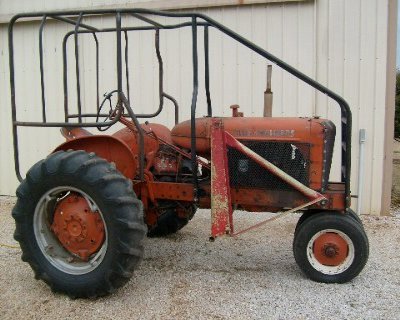| Author |
 Topic Search Topic Search  Topic Options Topic Options
|
Osage_Orange 
Orange Level


Joined: 11 Sep 2009
Location: SW MO
Points: 1593
|
 Post Options Post Options
 Thanks(0) Thanks(0)
 Quote Quote  Reply Reply
 Topic: Removing Fluid From Tires Topic: Removing Fluid From Tires
Posted: 15 Apr 2010 at 10:41pm |
What is the best way to remove the fluid from the rear tires of a WD45? I'm not sure, but think Calcuim Chloride is in them. Can that stuff be drained out on the ground or does a tire shop have to pump it out and dispose of it?.........tx...........O_O
|
|
Why is there never time to do it right the first time, but always time to go back and fix it?
|
 |
|
Sponsored Links
|
|
 |
Eldon (WA) 
Orange Level


Joined: 11 Sep 2009
Location: Spokane, WA
Points: 7765
|
 Post Options Post Options
 Thanks(0) Thanks(0)
 Quote Quote  Reply Reply
 Posted: 15 Apr 2010 at 11:19pm Posted: 15 Apr 2010 at 11:19pm |
|
Just unloaded an 18.4 x 28 tonight....here is what I do. I have an old bath tub that I plugged the drain hole in. I then lay the tire over the tub...I use the forks and skid loader....then remove the valve core and let the air pressure blow the fluid out. I had to air up the tire 4 times to get most of the fluid out, and I prop up one side of the tire to get the maximum amount out. I then bucket the CaCl into a plastic 55 gal barrel and sell it for dust control in the summer. You can also let it shoot out on the ground...won't get as much out but is faster. It won't hurt anything as it is just salt water...I actually saw CaCl as an ingredient in some pickles I bought....
|
|
ALLIS EXPRESS!
This year:
|
 |
acisbest 
Bronze Level

Joined: 09 Oct 2009
Location: SE, PA
Points: 142
|
 Post Options Post Options
 Thanks(0) Thanks(0)
 Quote Quote  Reply Reply
 Posted: 16 Apr 2010 at 5:47am Posted: 16 Apr 2010 at 5:47am |
|
Eldon,
Good procedure. By the time I get to removing the CACl its usually too late. Fluid is seeping from the tubes and the rims are corroded...
I have been able to remove the CACL on a few tires before the corrosion.
Is there anything that could be placed back into the tube for a bit to neutralize the CACL residue that is left over? I'm sure water might help. Would it even be worth doing?
|
 |
Jack(Ky) 
Orange Level

Joined: 12 Sep 2009
Location: Ky
Points: 1156
|
 Post Options Post Options
 Thanks(0) Thanks(0)
 Quote Quote  Reply Reply
 Posted: 16 Apr 2010 at 6:07am Posted: 16 Apr 2010 at 6:07am |
|
If you drain the tire and put back water and a little anti freeze the salt left in it would be so weak that I wouldn't think it would hurt anything. On a lighter note I have found that driving over sharp objects like broken bottles and old metal objects hidden by weeds and grass seem to be the quickest way to drain your tires but maybe not the best way.JP
|
 |
Brian Jasper co. Ia 
Orange Level

Joined: 11 Sep 2009
Location: Prairie City Ia
Points: 10508
|
 Post Options Post Options
 Thanks(0) Thanks(0)
 Quote Quote  Reply Reply
 Posted: 16 Apr 2010 at 6:52am Posted: 16 Apr 2010 at 6:52am |
|
When I had the tubes out of my tires, there wasn't much to start with, I used my shop vac to suck out the remaining fluid. I poured it on my gravel drive for weed control.
|
|
"Any man who thinks he can be happy and prosperous by letting the government take care of him better take a closer look at the American Indian." Henry Ford
|
 |
darrel in ND 
Orange Level


Joined: 22 Nov 2009
Location: Hebron, ND
Points: 8759
|
 Post Options Post Options
 Thanks(0) Thanks(0)
 Quote Quote  Reply Reply
 Posted: 16 Apr 2010 at 7:11am Posted: 16 Apr 2010 at 7:11am |
|
I had the fluid removed from a couple of my tractors by the local tire shop. The deal was they got to keep the chloride (which they could re-sell), and in exchange, I got the tires taken apart and new tubes put in. Didn't cost me a penny. I don't know if they are still doing deals like that anymore though, as chloride is losing its popularity. Darrel
|
 |
Chris/CT 
Orange Level

Joined: 11 Sep 2009
Location: Niantic, Ct
Points: 1939
|
 Post Options Post Options
 Thanks(0) Thanks(0)
 Quote Quote  Reply Reply
 Posted: 16 Apr 2010 at 7:19am Posted: 16 Apr 2010 at 7:19am |
|
I jack up one side, break bead, cut tube, let solution run out, rip tube out with remaining fluid, scoup out remaining fluid in bottom tire, wipe out with rags, sponge out. Wash up oif you like, install new tube, fill with air, drop, repeat on other side.
|
 |
Stan IL&TN 
Orange Level


Joined: 13 Sep 2009
Location: Elvis Land
Points: 6730
|
 Post Options Post Options
 Thanks(0) Thanks(0)
 Quote Quote  Reply Reply
 Posted: 16 Apr 2010 at 7:20am Posted: 16 Apr 2010 at 7:20am |
|
I jack up one side of the tractor, add air then rotate the valve stem to the bottom and remove the valve core. After doing this several times you have most of it out and then the tire/wheel is easier to remove and handle if replacing tires or tubes.
|
 |
CTuckerNWIL 
Orange Level


Joined: 11 Sep 2009
Location: NW Illinois
Points: 22825
|
 Post Options Post Options
 Thanks(0) Thanks(0)
 Quote Quote  Reply Reply
 Posted: 16 Apr 2010 at 8:20am Posted: 16 Apr 2010 at 8:20am |
|
You can drain it on the ground but, nothing will grow there for a couple years. You can spread it on a gravel driveway or road and it will draw moisture and keep the dust down for a month or 2.
Why do you want to drain the fluid? Fluid in a tube will only add ballast to your tractor, it will not rust your rim. Rims usually go bad because the valve core leaks and that won't happen if you change them out every couple years. If you do drain it, unless you do like Eldon does, you will need to remove the tire form the rim to flush and clean all of the fluid. You will just quicken the rusting process if you try to drain the fluid and shove a new tube in and go. Any fluid that gets on the rim anywhere needs to be flushed off. If you have a leak somewhere drain it and remove the tire, clean and paint the rim and replace the tube.
Another point to consider is whether you ever plan on working the 45 again. You can't hardly add enough weights to make up for the fluid and ballast is needed to plow or use a loader. Of course you can use windshield washer fluid, used antifreeze or Rim Guard to replace the CaCl. JMO
|
|
|
 |
GregLawlerMinn 
Orange Level


Joined: 11 Sep 2009
Location: Lawler, Mn
Points: 1226
|
 Post Options Post Options
 Thanks(0) Thanks(0)
 Quote Quote  Reply Reply
 Posted: 16 Apr 2010 at 9:20am Posted: 16 Apr 2010 at 9:20am |
I'm with CTuckerNWIL. After having the tire shop pump out the fluid fron the various rehab tractors over the years (primarily to remove the tubes and clean up the rims; recommend this to anyone rehabbing an old tractor). After the rehab was done to fix the known, and discovered, issues, I used to check out the tractor by running them W/O fluid. I was unhappy that I could not "put the power to the ground" to really check out the condition of the engine and mechanical components. I now am adding CACL for weight after the rehab is initially done.
Tire shop folks claim that the CACL does not attack the rubber in the tube and that leaks start from punctures or corroded valve cores. They recommend changing out the cores every other year. They recommend doing this by jacking up one side, rotate tire so valve stem is on top, remove the core (carefully as there is pressure in the tire), clean opening with a Q-tip, swab a little vaseline on the new stem and install. Air up the tire and lower to the ground.
Been doing this now for several years and am now able to "put the power to the ground" when plowing or disking (thus testing out the completeness of a rehab).
|
 |
Matt MN 
Orange Level


Joined: 14 Sep 2009
Location: Silver lake MN
Points: 1491
|
 Post Options Post Options
 Thanks(0) Thanks(0)
 Quote Quote  Reply Reply
 Posted: 16 Apr 2010 at 9:23am Posted: 16 Apr 2010 at 9:23am |
|
I totally agree with CTuckerNWIL, CaCL inside the tube will never rust the rim. A little "maintance" and the rim will not rust. Keep them clean and watch for leaks and have the leaks fixed. I have my grandpa's WC that has had Fluid in the rear tires for over 50 years and the rims are not rusted at all. But we have always kept our eyes on the tires and washed them off 1-2 times a year.
|
|
Unless your are the lead horse the scenery never changes!!
|
 |
Eldon (WA) 
Orange Level


Joined: 11 Sep 2009
Location: Spokane, WA
Points: 7765
|
 Post Options Post Options
 Thanks(0) Thanks(0)
 Quote Quote  Reply Reply
 Posted: 16 Apr 2010 at 9:30am Posted: 16 Apr 2010 at 9:30am |
|
I wonder how many corrosion problems started from a hasty field repair when everything was not cleaned properly....
|
|
ALLIS EXPRESS!
This year:
|
 |
Osage_Orange 
Orange Level


Joined: 11 Sep 2009
Location: SW MO
Points: 1593
|
 Post Options Post Options
 Thanks(0) Thanks(0)
 Quote Quote  Reply Reply
 Posted: 16 Apr 2010 at 10:39pm Posted: 16 Apr 2010 at 10:39pm |
Are the tires more likely to be punctured by sharp rocks or sharp stumps when fluid is present? Seems like the heavier tire would be more likely to puncture.......My tractor is used mostly for brush hogging and dragging brush...........O_O
|
|
Why is there never time to do it right the first time, but always time to go back and fix it?
|
 |
7060 
Orange Level


Joined: 16 Sep 2009
Location: Missouri
Points: 1148
|
 Post Options Post Options
 Thanks(0) Thanks(0)
 Quote Quote  Reply Reply
 Posted: 16 Apr 2010 at 10:58pm Posted: 16 Apr 2010 at 10:58pm |
Ive got a 7030 parts tractor that someone put fluid in the tires. They didnt have tubes in them either. When I got it one wheel was rusted out halfway around right next to the tire bead. Don't know how long it lasted but theres hardly anything left of the rim.
|
 |
Tricky Dickie 
Silver Level

Joined: 05 Nov 2009
Location: North Yorkshire
Points: 186
|
 Post Options Post Options
 Thanks(0) Thanks(0)
 Quote Quote  Reply Reply
 Posted: 17 Apr 2010 at 3:53am Posted: 17 Apr 2010 at 3:53am |
I have never been able to understand why tyre companies fill tyres with CaCl solution when a couple of gallons of ordinary ethylene glycol anti-freeze added to the water will keep the tyre safe by ensuring that the worst that can happen at freezing temperatures is that the water ballast turns to slush. Glycol is harmless to tyre rubber (and rad hoses!) and is very effective. When I was a boy, my father would always insist that glycol was used in the tyre ballast of all the tractors on his farm and he never had a problem in freezing weather over the many years that water ballast was used! CaCl is filthy muck - it is disgusting to handle and has ruined countless wheel rims by rotting them out. It is the worst option as a tyre anti-freeze. Don't use it!!
Tricky Dickie
|
 |
RoyR (MI) 
Bronze Level

Joined: 12 Sep 2009
Location: Reading, MI
Points: 10
|
 Post Options Post Options
 Thanks(0) Thanks(0)
 Quote Quote  Reply Reply
 Posted: 17 Apr 2010 at 6:22am Posted: 17 Apr 2010 at 6:22am |
|
The main reason CaCl is used instead of glycol is the additional weight that can be added with the dissolved salt. I think the brine solution is about 11 pounds per gallon vs. 8 for water / glycol.
|
--------------
Roy

|
 |
Dick L 
Orange Level


Joined: 12 Sep 2009
Location: Edon Ohio
Points: 5093
|
 Post Options Post Options
 Thanks(0) Thanks(0)
 Quote Quote  Reply Reply
 Posted: 17 Apr 2010 at 6:31am Posted: 17 Apr 2010 at 6:31am |
|
Easiest way I found to remove calcium chloride was to run over a plowed under steel rusted T fence post at the back of the farm. By the time you get to the house it is bout gone. Neglect is the cause of rusted rims from calcium chloride. Like so many things something has to let the gene outa the bottle.
|
 |









 Topic Options
Topic Options

 Post Options
Post Options Thanks(0)
Thanks(0)











